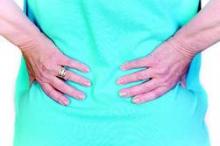SAN DIEGO – Patients presenting to emergency departments with acute low back pain who were treated with nonsteroidal anti-inflammatory drug monotherapy did as well as those who received an NSAID combined with an opioid or muscle relaxant, though combination therapies are far more commonly prescribed in the ED.
At the annual meeting of the Society for Academic Emergency Medicine, Dr. Benjamin W. Friedman of Montefiore Medical Center in New York presented results from a trial of 323 adult patients aged 64 and younger at Montefiore’s emergency department who had acute low back pain not related to trauma, and functional impairment.
Patients were evaluated at baseline using the Roland Morris Disability Questionnaire (RMDQ), and randomized to receive naproxen sodium 500 mg along with placebo tablets (n = 107), cyclobenzaprine 5 mg (n = 108), or oxycodone 5 mg/acetaminophen 325 mg (n = 108) for low back pain. Patients and clinicians were blinded to treatment assignment.
Subjects were advised to take naproxen sodium along with 1 or 2 tablets of the study drug, every 8 hours as needed. They were followed up by telephone 1 week later and again at 3 months, with 92% followed up at 3 months.
At 1 week after the ED visit, there were no clinically or statistically significant differences seen among the treatment groups in improvements measured by RMDQ scores, with placebo subjects showing a mean improvement of 9.6% (98% CI, 7.7-11.5); cyclobenzaprine subjects, 10.1 (98% CI, 7.9-12.3); and oxycodone/acetaminophen subjects, 10.9 (98% CI, 8.9-13.0). At 3 months, functional and pain outcomes did not differ significantly among the groups.
Adverse events were lowest in the placebo group, with 21% of patients reporting at least one after the first week, compared with 34% for cyclobenzaprine and 40% for oxycodone; the most commonly reported effects were drowsiness, dizziness, and gastric symptoms. “This works out to a number needed to harm for cyclobenzaprine of eight, and for Percocet [oxycodone/acetaminophen] of five,” compared with placebo, Dr. Friedman told the conference.
However, he noted, of the patients who adhered to the study medications – that is, who took them more than once – only 30% of those on oxycodone reported moderate or severe back pain at 1 week, compared with 48% of patients taking placebo, a statistically significant difference, though overall RMDQ improvement did not differ among the groups.
“Giving [oxycodone] to all your patients with lower back pain is a strategy that’s not going to work,” he said. “But if you limit it to patients who really need it and are likely to adhere to it, that’s a population who might see a benefit. Just remember, the number to harm needed is five. Don’t prescribe this medication lightly.”
Dr. Friedman said that low back pain complaints account for 2.4% of all ED visits in the United States, or 2.7 million visits annually, and that more than half of ED prescriptions for low back pain comprise combinations of two of the drug classes, with 16% of prescriptions combining all three.
Dr. Friedman’s study was internally funded and neither he nor his coinvestigators disclosed conflicts of interest.


